The Green Hydrogen Industry Needs a Manufacturing Makeover
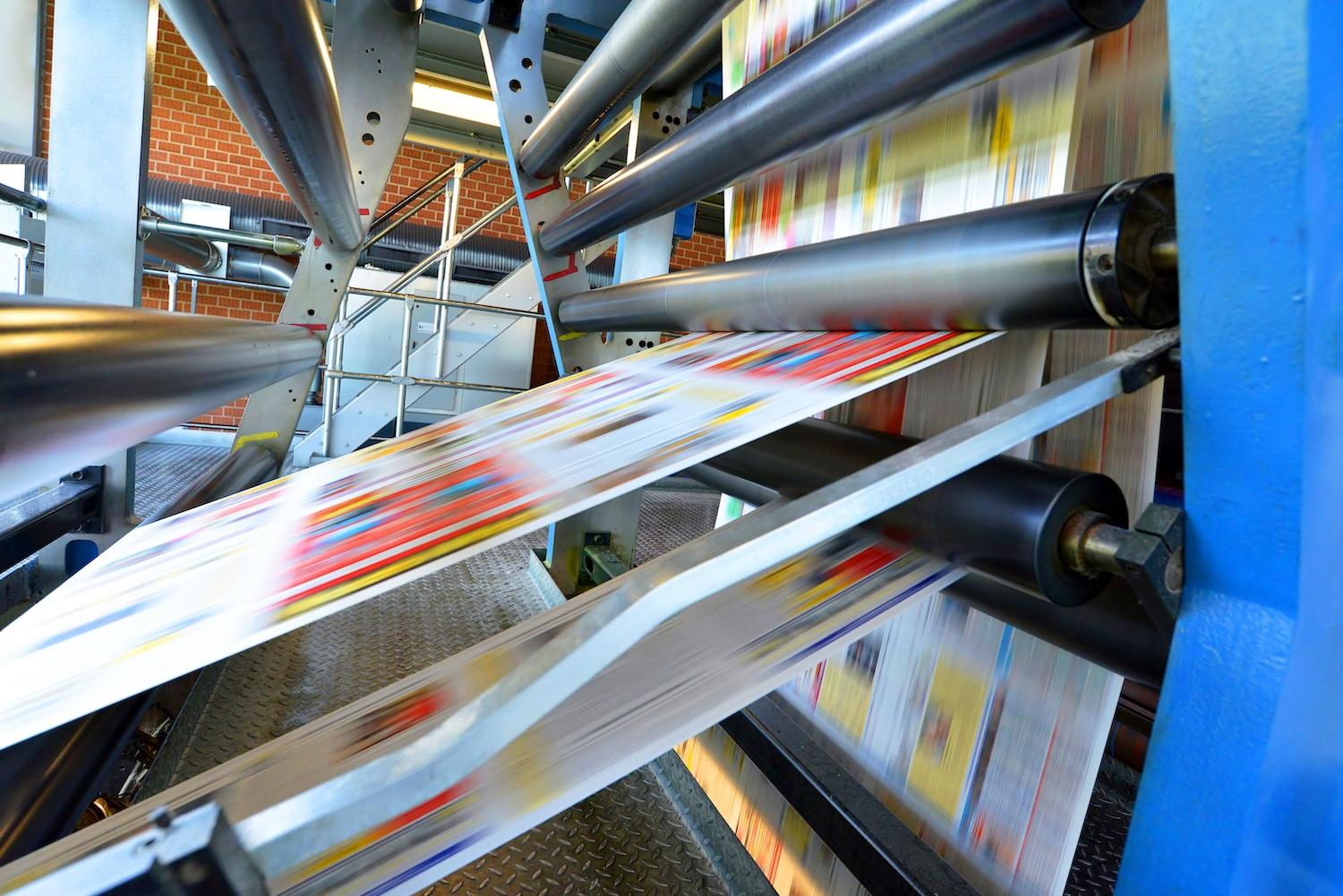
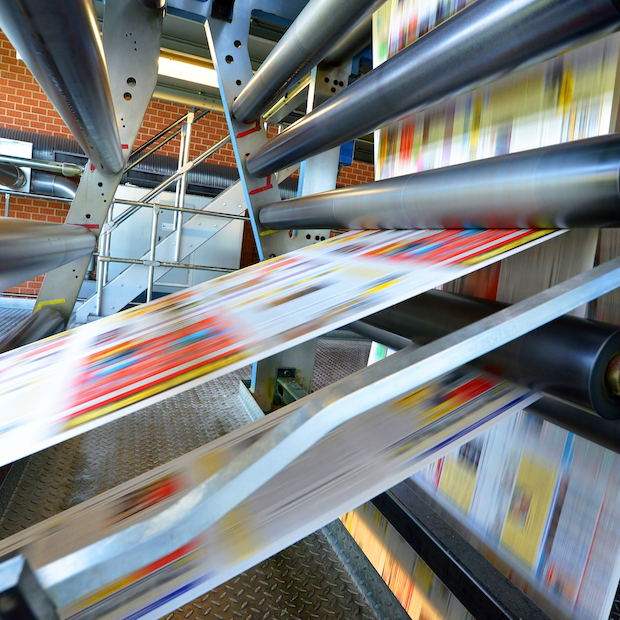
3M and Evoloh are developing a system that uses roll-to-roll manufacturing, which you might recognize as the process used to print newspapers, to reduce the cost of building the devices that make green hydrogen. (Image: industrieblick/Adobe Stock)
Green hydrogen is a key driver of the global decarbonization effort, but it faces a scale-up problem. The electrolyzer systems that generate green hydrogen are expensive and cumbersome to manufacture. A faster, cheaper manufacturing strategy is needed, and industry stakeholders are developing solutions.
From tape to the energy transition
The well-known U.S. firm 3M provides an example of stakeholder interest in new electrolyzer manufacturing systems. The company launched in 1902 with a focus on new kinds of sandpaper.
Since then, it compiled extensive background in two areas that apply directly to the electrolyzer problem, materials science and roll-to-roll manufacturing, which involves feeding a flexible material through a system of rollers to print on it, cut it, or coat it, among other things. That experience is reflected in the company’s roster of products manufactured with roll-to-roll systems, including the introduction of recording tapes in the 20th century.
The roll-to-roll difference
Tape recorders have faded from use in the 21st century with the rise of digital technology, but the rapid-fire pace of roll-to-roll manufacturing is still at work in the energy transition. The U.S. Department of Energy, for example, promoted roll-to-roll systems as a means of scaling up the manufacture of new thin film solar cell technology.
To get a picture of the difference roll-to-roll manufacturing can make in the electrolyzer field, consider its impact on the printing industry. The first printing presses emerged in the 15th century, requiring operators to place a single piece of paper on a flat surface, stamp it and remove it. The stamping method held sway until the 19th century when printing houses incorporated cylinders. Instead of breaking the process into steps, cylinders enable a continuous flow of material from one roll to another.
The high speed of cylinder-based printing was showcased to dramatic effect in famous films of the 20th century, such as “Citizen Kane,” where newspapers are shown whizzing around machinery the size of an entire factory floor in a seamless flow.
Roll-to-roll printing and green hydrogen
Electrolyzers are composed of cells arranged in stacks. They push hydrogen from water with an electrical current. When that current is provided by renewable energy, electrolyzers offer a green alternative to the fossil resources needed for conventional hydrogen.
The implications for the energy transition are widespread. In addition to decarbonizing fuels and industrial systems, green hydrogen production can contribute to grid reliability and stimulate further investment in renewable energy projects.
“With the expansion of renewables as a clean energy input, we can align supply and demand on the grid, and we can use those otherwise unused electrons and put that in a water electrolyzer,” Andy Steinbach, senior research specialist at 3M, told TriplePundit. “This is an opportunity from a technology standpoint.”
Before that opportunity can be realized, the cost of green hydrogen needs to be competitive with fossil resources. Estimates vary, but the U.S. Department of Energy uses the standard figure of $5.00 per kilogram for green hydrogen. It’s set a goal of reducing that by 80 percent within 10 years, down to $1.00 per kilogram, with an intermediary step of $2.00 per kilogram by 2026.
In terms of competition with fossil energy, the gap is narrowing. The cost of making hydrogen from natural gas ranges from $0.50 to $1.70 per kilogram depending on the market, according to the International Energy Agency. Attaching carbon capture systems to the process bumps up the range to $1.00 to $1.70 per kilogram, further closing the gap.
The Energy Department’s goal is consistent with a 2020 report on electrolyzer manufacturing issued by the International Renewable Energy Agency. It concluded that the cost of electrolyzer systems could drop by 40 percent over the short term and up to 80 percent over the long term if the industry scales up, standardizes and draws lessons from early adopters.
As viewed by 3M, one of those lessons is to move electrolyzer manufacturing from partial to full automation.
“A lot of the components are [currently] built in a semi-automated process,” Tim Yamaya, a corporate entrepreneur at 3M, told TriplePundit. “They are partly hand-assembled, and the industry is trying to get to fully automated production.”
Yamaya also drew attention to the impact of electrolyzer costs on the competitiveness of green hydrogen.
“3M’s focus is to enable renewable hydrogen to be cost competitive. We want to enable that through high-performance materials and process expertise,” Yamaya said, referring to the $1.00 per kilogram goal of the Energy Department.
Investing in the green hydrogen industry of the future
Towards the goal of reducing the cost of manufacturing, 3M Ventures, the company’s venture capital arm, invested in the electrolyzer firm Evoloh.
Evoloh is developing a roll-to-roll system for manufacturing low-cost electrolyzer “stacks.” The company is also cutting costs by eliminating expensive or rare materials in favor of inexpensive, locally sourced materials including steel and aluminum as well as plastic. Among other cost-cutting measures, Evoloh won a grant from the U.S. Department of Energy aimed at deploying plain tap water instead of the purified water required by conventional electrolyzers.
Bill Weber, the business building director at 3M Ventures, told TriplePundit that the company plans to contribute its experience driving down material costs in the direct air carbon capture field to help Evoloh scale up its manufacturing system.
“Evoloh’s ambition is to do electrolyzer stacks roll-to-roll,” he explained, “And we also do carbon capture materials roll-to-roll, so we can rapidly create the scale that the world needs.”
More support for roll-to-roll systems
The potential to introduce rolls-to-roll systems in electrolyzer manufacturing has also caught the attention of the U.S. Department of Energy. The agency announced the launch of the new R2R Consortium, a collaborative effort involving five of its research laboratories, this year.
“Roll-to-roll manufacturing can reduce costs by increasing process efficiency and reducing material waste, but there are challenges related to materials synthesis, coating, drying, and quality control that need to be addressed to scale up these processes for industry adoption,” according to the department.
The focus on roll-to-roll printing is a timely one. In its latest global hydrogen market review, the International Energy Agency warned that demand for electrolyzers is “highly uncertain,” as the industry continues to struggle with costs.
And in May, the International Council on Clean Transportation advised that “where costs will land in the future can’t be known with certainty.”
Nevertheless, investor interest in producing green hydrogen continues to show signs of life, as recently illustrated in the U.S. by the announcement of two new projects totaling 8 gigawatts in Texas.
If 3M, Evoloh, the Energy Department and other stakeholders realize their plans for reducing the cost of electrolyzer manufacturing, the future of green hydrogen will look much more certain than it does now.
These High School Scientists Are Building Wildfire Solutions
Jason Zhao working on the rocket he designed to detect and monitor wildfires. (Image courtesy of Jason Zhao.)
In May, about 2,000 young scientists from high schools around the world presented research and solutions for critical societal issues such as climate change and diseases.
Students can only compete at the Regeneron International Science and Engineering Fair after winning the top prize at a local, regional, state or national science fair. TriplePundit sat down with three of these young scientists to discuss their research and the tools they created for wildfire mitigation and adaptation.
Measuring long-term human health impacts from wildfire smoke exposure
“Here in Montana, and Missoula specifically, wildfire smoke seasons have been getting worse over time,” said 18-year-old Amy Boote. After noticing health effects in herself and her family, she became interested in discovering more about how wildfire smoke affects lung function over time in otherwise young, healthy adults.
There are not many studies on the long-term health impacts of wildfire smoke exposure. So Boote looked for historical data from the Environmental Protection Agency on particulate matter — microscopic solids and liquids — emitted by wildfire smoke. She focused on PM2.5, or particulate matter less than 2.5 microns in diameter.
“PM2.5 can penetrate into your lungs and cross into your bloodstream,” Boote explained. She recruited 18- to 30-year-olds with no history of smoking or vaping and surveyed them to determine their medical history and total lifetime exposure to wildfire smoke based on where they lived every year of their lives. She then tested each participant’s lung function.
“After analyzing the data, I saw there was a significant correlation between lifetime wildfire PM2.5 exposure and decreased lung function,” Boote said. “Capacity continued to decrease with repeated exposure.”
She also noted that more time spent living in Missoula significantly correlated with lifetime increased exposure to wildfire smoke.
“It was surprising that [the participants] were seeing decreased lung function because they were younger, healthier and more active,” Boote said. “They were not in sensitive groups, like being older with pre-existing conditions.”
Moving forward, Boote wants to see more research on mitigation strategies to reduce exposure to wildfire smoke, including which strategies are most protective.
“This is so important because more and more people are being exposed to repeated wildfire smoke events,” she said. “Human-caused climate change is driving the increase in wildfires globally and here in Montana. Here, our wildfire season has gotten three times longer, and total wildfire smoke exposure is increasing globally.”
Monitoring park visitor safety and forest fires with radio technology
“Every year, 2,000 hikers go missing in the U.S., which makes up half of all missing people in the country,” explained 17-year-old John Parsons. “I wanted to do something that can help people.”
Parsons developed a system of solar-powered transceivers, which are wireless communication devices that use radio waves, to keep hikers and park visitors safe while monitoring for forest fires. The transceiver sits inside a weatherproof box about the size of a shoebox with a small solar panel attached.
“The idea is that when hikers enter parks, park rangers would give them a small device to take with them,” Parsons explained. “The transceiver boxes could be placed in the trees in the forest, and as hikers go through, it records their location with GPS. They can also hit a button on their device if they are in distress.”
The boxes also contain smoke detectors that notify park rangers of the location of fires via the transceiver system.
The most common methods for monitoring forest fires are satellite imagery or using fire watch towers, but those are less effective at night or in misty conditions, Parsons said.
“The reason that this system is needed is because you cannot build major infrastructure in a national park, but the transceiver is tiny,” he said. “They are unobtrusive to the environment and barely noticeable. There is no visual impact.”
Parsons acknowledged that, currently, the system has a limited range of up to 60 meters. However, he believes that the range can be improved. “I have a bunch of ideas for other improvements, too,” he noted. “I would love to put a small keyboard on the hikers’ modules to encode a message into radio waves, so it could specify the problem and location for the rangers.”
This was Parsons’ first year doing a science fair, and he received the Soumyanath Memorial Award, winning a cash prize for himself and his school. Before starting the project, he taught himself circuitry and soldering using online videos and brushed up on his coding skills.
Reflecting on what he learned at the fair, he said, “If you have a good idea, work on it. You miss 100 percent of the shots you don’t take.”
Low-cost, rapid response solutions for wildfire hotspot detection
“The 2023 wildfire season was the most disruptive ever in Canadian history,” said 17-year-old Jason Zhao. “I decided I wanted to help speed up the firefighting process.”
Zhao designed and built a rocket that deploys drones to detect and monitor wildfires. “The first step of wildfire suppression is identifying hot spots,” Zhao explained. “You need to get an infrared camera above it to make a plan.”
Typically, wildfire hotspots are detected using helicopters, butt helicopters are not very fast and need specialized airports nearby to take off from, Zhao said.
“Most importantly, helicopters have people inside of them,” he said. “In the past four years, 12 firefighters have died monitoring wildfires. That is the system I am trying to improve.”
Zhao set meetings with his local fire department to better understand its needs. To increase production efficiency, he used 3D printing technology to design and manufacture many of the rocket components. The rocket takes off with the drone inside, and once reaching the forest, separates from the drone, deploys parachutes and falls to the ground. The drone continues on to monitor hotspots.
“The advantage of my system is that a rocket does not need to take off from an airport,” Zhao said. “It could be stored at the fire department. Rockets are much faster than helicopters. And the worst-case scenario is that you lose a drone, but in that case, nobody has died.”
Zhao has tested his rocket twice. During his first launch in Tri-Cities, Washington, he flew the rocket 1.7 kilometers high. He adjusted the design, and on his second launch in the Mojave Desert, the rocket reached heights of over 3 kilometers and flew at 1.4 times the speed of sound.
Zhao is continuing to improve some of his system's current limitations, including improving drone efficiency, increasing the drone’s battery life, adding more sensors and instruments, and improving the software to run on autopilot. His project won a special award and a second-place award in the aerospace category.
Building a global community of solutionists and innovators
While the Regeneron International Science and Engineering Fair provides students with an opportunity to demonstrate the quality of their work in a competition setting, it also fosters international collaboration among young students. Zhao attended with the intention to compete but was surprised by the friendships he built.
“Going to ISEF was one of the best experiences of my life,” he said. “I was able to make lifelong friends in just seven days.”
Parsons’ comments echoed Zhao’s: “It was mind-blowing. It was life-changing. I’ve never had an experience like that.”
And so did Boote’s.
“It was really cool to meet people from all over the world who had put a ton of work into doing a science research project and were knowledgeable and passionate about their areas of research,” Boote said. “People around me were from Sweden, Puerto Rico, Hungary and Turkey. And people were speaking all kinds of different languages, but in the end, we were all high schoolers who had done scientific research.”
3 Ways Images Can Help You Tell Your ESG Story
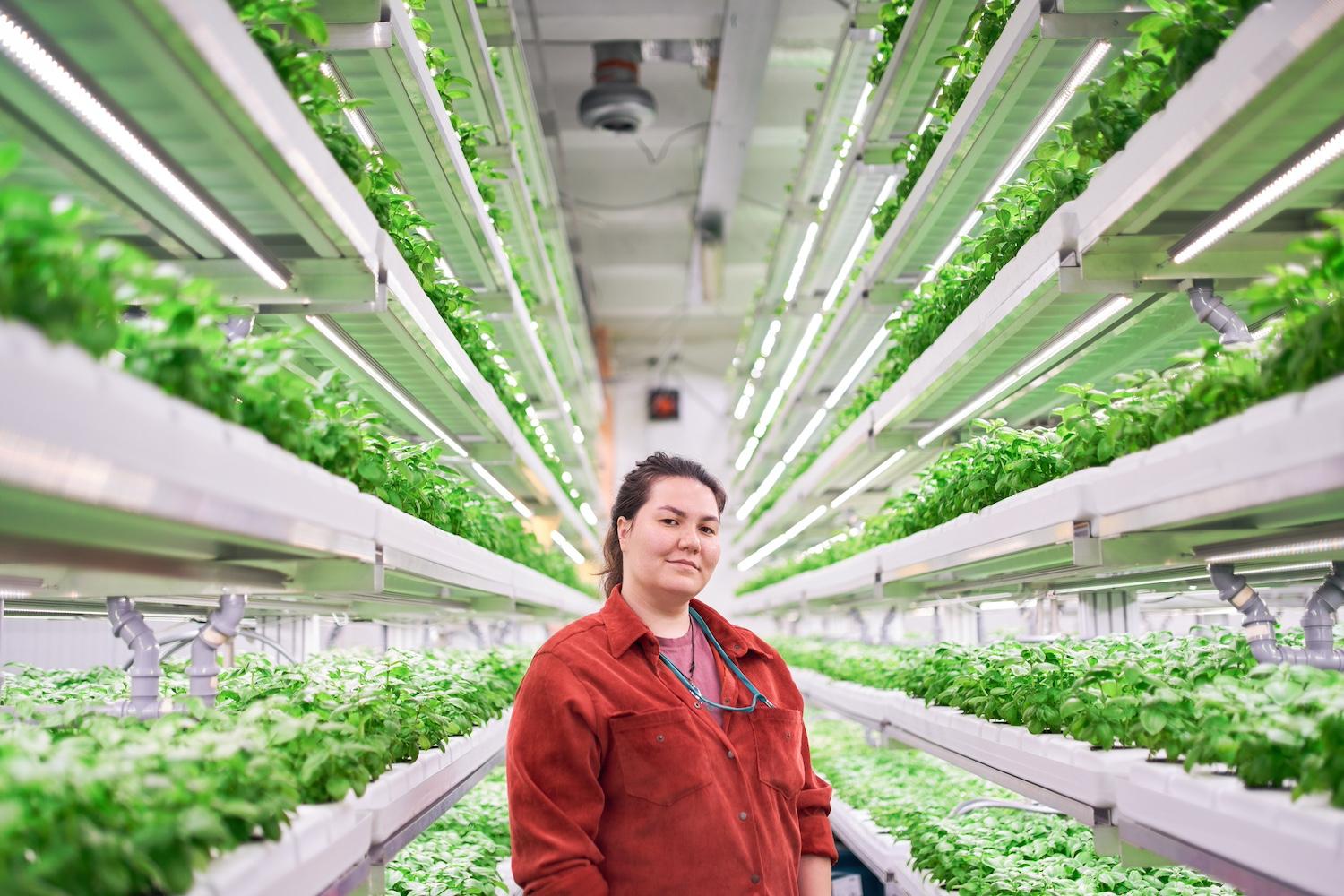
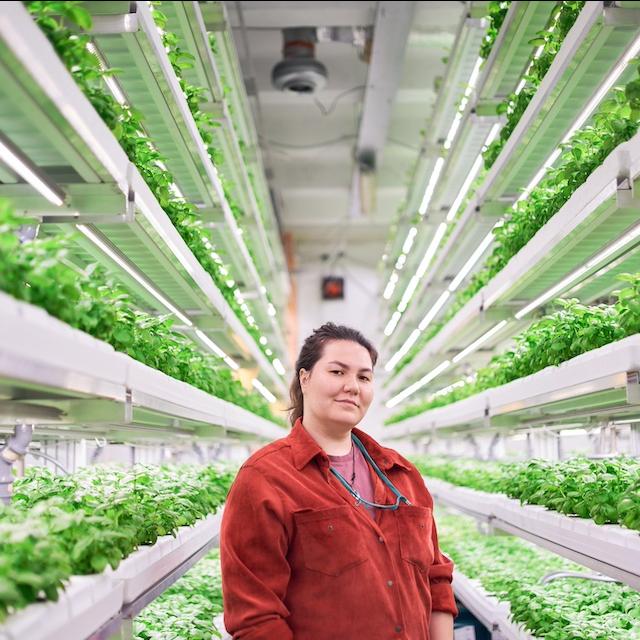
(Image courtesy of Getty Images.)
A fear of greenwashing has led to another problem for many companies: greenhushing. Greenhushing, or the downplaying of ESG (environmental, social and governance) efforts, is on the rise as companies seek to avoid changing political headwinds and outside scrutiny. But 83 percent of Europeans believe companies have a moral obligation to improve society and the environment with the resources they have, according to research from the visual media company Getty Images. Additionally, 71 percent of American consumers believe it is important for companies to have ESG guidelines and practices.
TriplePundit sat down with Sammy Malave Jr., manager of creative insights at Getty Images, to understand how organizations can use images to authentically communicate their sustainability commitments and, ultimately, reach more consumers.
“There is a lot of global pressure around brands getting ESG messaging right, given the importance and weight of meeting the UN goals by 2030. Brands want to get it right and are fearful of greenwashing,” Malave said. “Our research tells us in many ways that ESG, specifically, is very important to consumers … ESG is up there with profit as a metric of success.”
1. Your sustainability visuals should reflect consumers’ daily lives

While companies might be tempted to use aspirational imagery in their sustainability communications, visuals are most effective when they are authentic representations of the present.
“We know from the image testing we do … that consumers relate best to images that feel reflective of everyday life,” Malave explained. “An ad for an electric vehicle should feel like a slice of life of a family that just so happens to operate an EV. That philosophy should extend to all brands. If you are authentic to yourself as a brand, it will feel authentic to consumers.”
Visuals are most impactful when they accurately and authentically depict the ways in which consumers interact with a company.
“We need to understand the way that, as a brand, you are attempting to make an impact,” Malave said. “Be honest and visualize it in a way that makes sense, showing what impact looks like for the brand and what it looks like for consumers.”
2. Visuals should accurately reflect financial priorities

Visuals should be used to emphasize the areas that companies have adequately resourced.
“We should be asking brands to be introspective,” Malave said. “When you do your ESG or CSR reports, where are you placing your emphasis and investment?”
Visuals that do not align with well-resourced corporate priorities are at risk of being labeled as inauthentic or greenwashed.
“Sustainability is not about using green imagery, but it is about holding the supply chain accountable and doing the DEI [diversity, equity and inclusion] work and decarbonization,” Malave said. “The emphasis and investment will differ company by company, but brands should take an honest look of where they are making the impact so it can show up in marketing and seem authentic to both the brand and the consumers’ way of life.”
3. For authentic visual representation, stakeholder engagement is key

To understand what kind of sustainability imagery will best resonate with consumers, companies must have robust stakeholder engagement strategies. Sustainability is critical for developing customer loyalty over the long-term, but the messaging must be authentic.
“You do that by listening and paying attention, being honest about what consumers want, and how your brand can participate in community empowerment and DEI and all of the things that ladder up to make a sustainable business,” Malave said. “We must ask brands to understand the holistic nature of ESG and understand where consumers fit into that.”
When selecting images for marketing and corporate communications, brands should lean on the ways in which they help consumers in their own personal sustainability journeys.
“Authenticity is important in the depiction of sustainable imagery,” Malave said. “Companies cannot rely on tropes and the color green and surface level representations of sustainability, like the very stale image of someone dropping something into a recycling bin. It is a challenge to move past that. It is difficult to go a level deeper, but it is not impossible.”
Improving Disaster Outcomes by Bridging Language Gaps in Houston
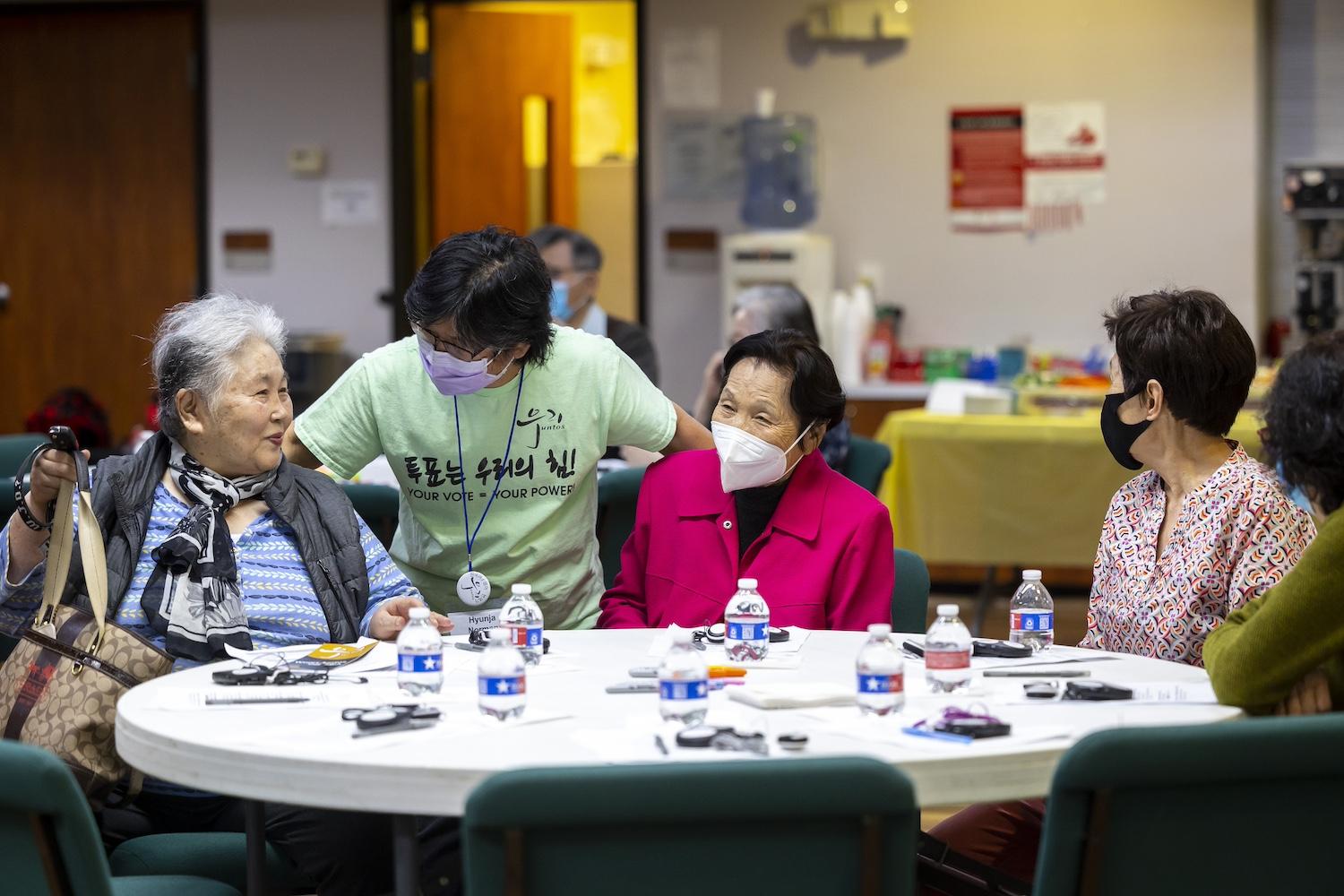
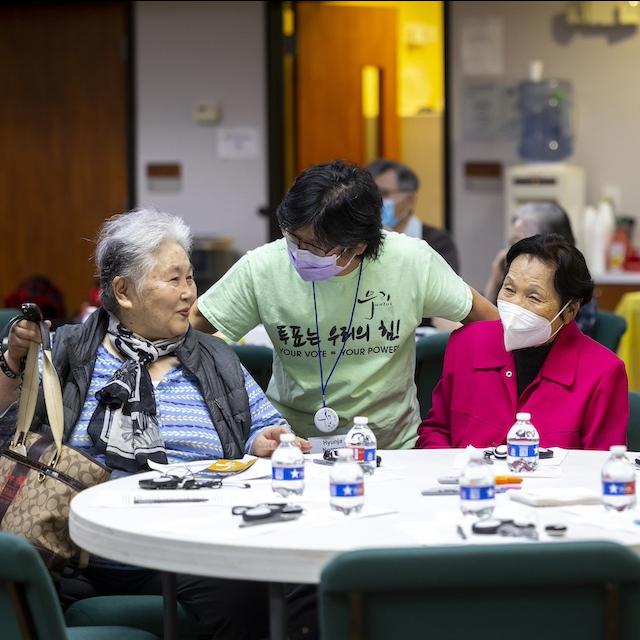
(Image courtesy of Woori Juntos.)
Natural disasters are terrifying enough in their own right. Imagine being unable to understand warnings, directions, emergency declarations, or how to access post-disaster relief because the information is broadcast in a langue you aren’t proficient in. That’s the reality for many immigrants and refugees, and it’s more than just an inconvenience. Lack of language inclusivity puts lives at risk.
While there are laws requiring language accessibility where federal funding is concerned, enforcement is lax. When speakers of a specific language make up less than 5 percent of the total population in the area, those laws might not apply anyway. Compounded with systems that create challenges to accessing emergency information in various languages, immigrants are often left in the dark — literally.
“Some people were in the dark, were in the heat, and didn’t have access to get to the cooling center, and didn’t have access to call us and let us know that they needed help,” Quỳnh-Hương Nguyễn, the senior communication associate at Woori Juntos said, referring to a deadly storm that swept through Houston, Texas, in May. Similarly, emergency notifications for a chemical fire in the city last year were only sent out in English and some Spanish, leaving many without proper warnings or instructions.
Woori Juntos aims to address these issues by empowering the Asian, immigrant and migrant communities in Houston. The organization focuses on helping them navigate local services and organize to advocate for policy.
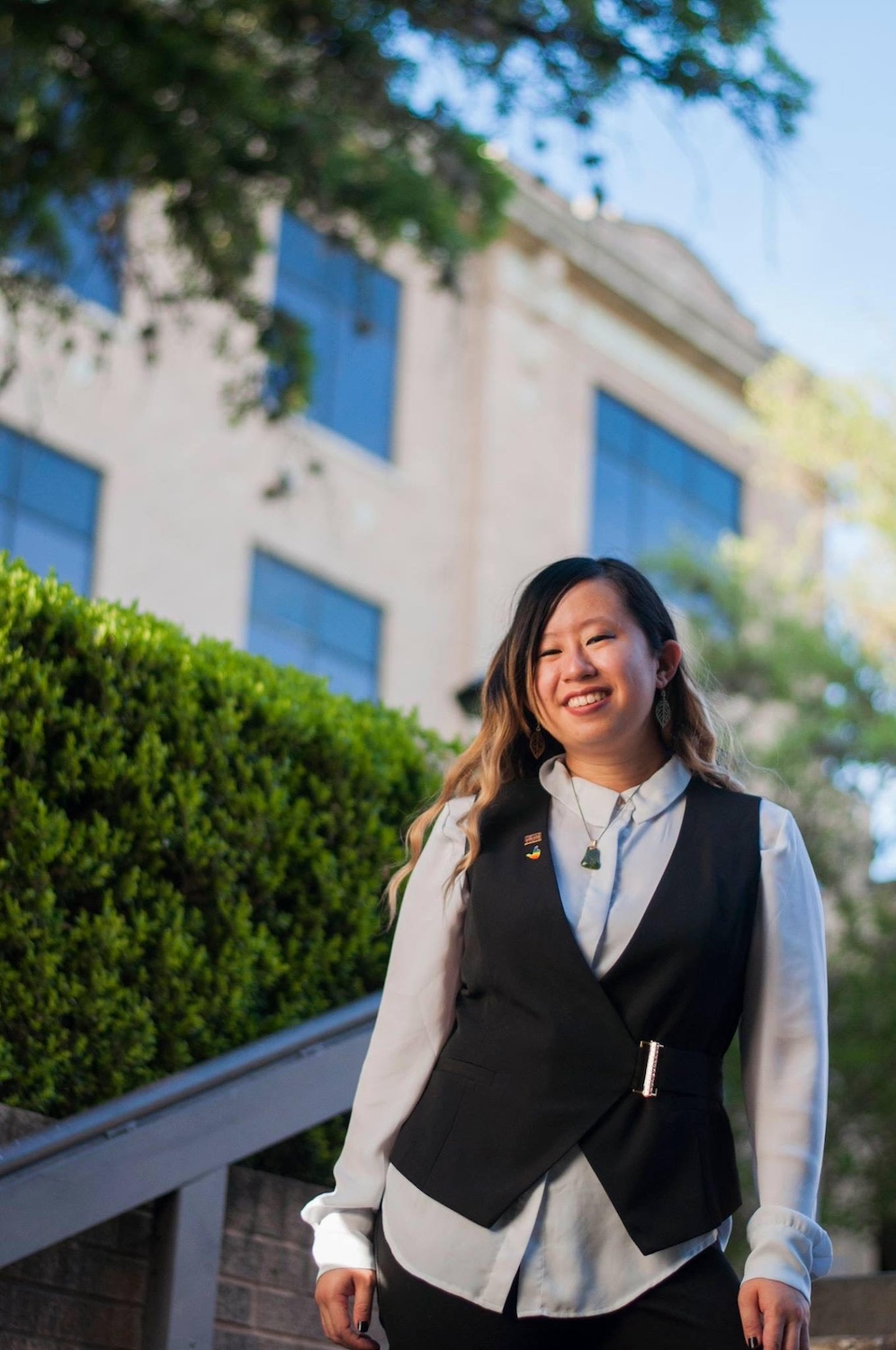
Jumping through hoops for language access
“No one was informed about it,” Nguyễn said of the recent storm. “It was only afterwards where people were getting information … like, ‘There's a few cooling centers, there's a place to charge, there's a place to get to get rid of tree debris.’ Now the problem with that, again, is it’s all English focused. So if you are a Korean member or a Spanish-speaking member, and let's say this big tree is in your house right now, how do you get that [removed]?”
Instead of automatically supplying emergency notifications and recovery information in all relevant languages for an area, English is often the default. In Houston specifically, community members have to sign up for alerts online, and that form is also in English, Nguyễn said. This creates a huge barrier for people who are not tech-savvy, especially the elderly, who are the most vulnerable in emergencies.
Further complicating emergency response — whether it be due to a natural disaster or personal health crisis — first responders don’t speak many of the languages present in the community. As a result, many immigrants struggle to get the help and treatment they need from police and medical professionals, Nguyễn said. This leaves organizations like Woori Juntos scrambling to help with translation and access to services to keep community members who would otherwise slip through the cracks safe during emergencies.
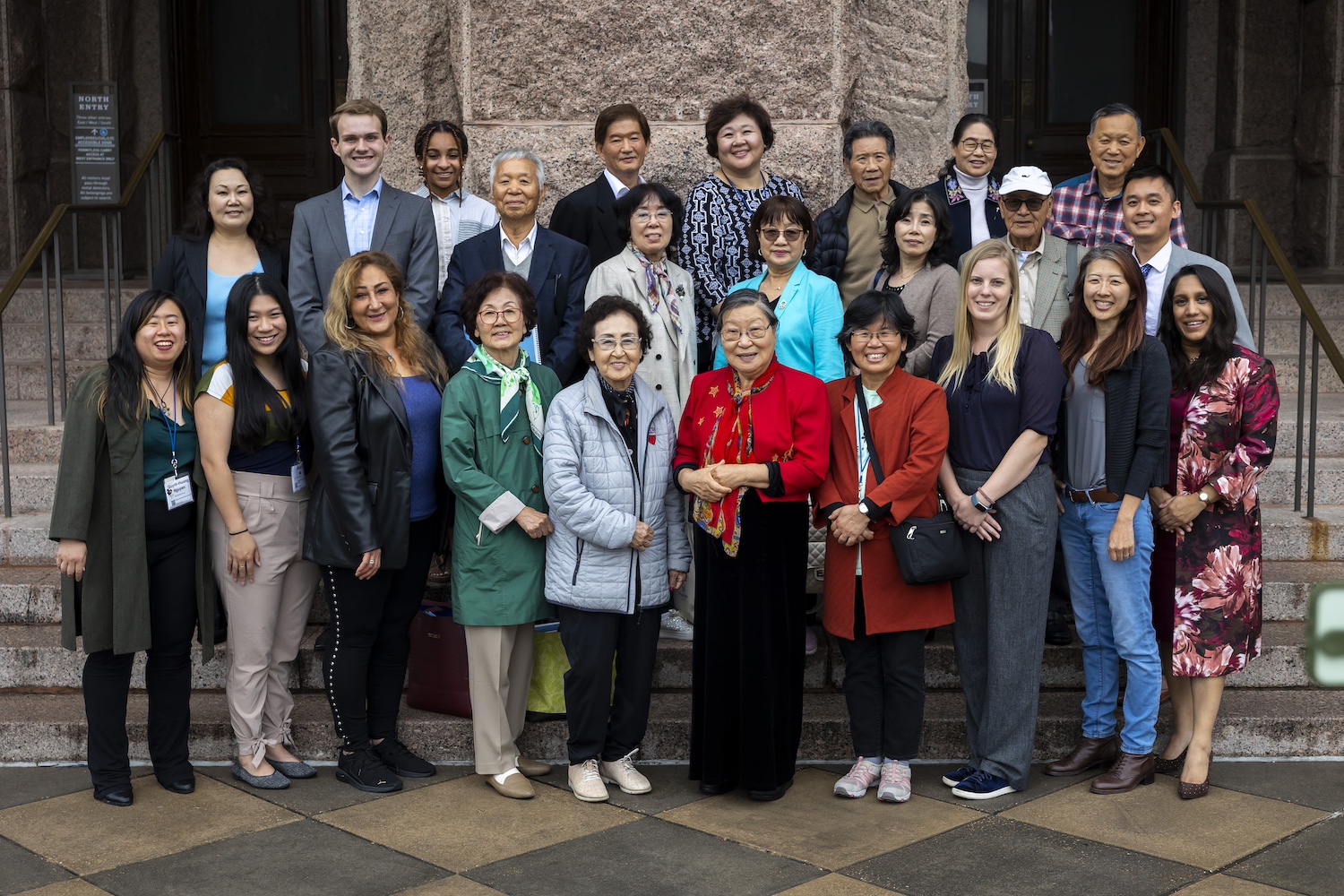
Bridging the language gaps
Woori Juntos means “we rise together” in a combination of Korean and Spanish. The organization works primarily with Korean, Vietnamese and Spanish-speaking immigrants, many of whom are from Central America. But it also works with smaller immigrant groups such as those from Laos and Cambodia. The organization doesn’t turn anyone away for language reasons and works with interpreters to bridge any gaps.
“On the service side, we focus mainly on helping a lot of our Korean elders, or Korean folks in general, to navigate a lot of the public system if they do not have a relative who can speak proficient English,” Nguyễn said. This includes navigating health care, citizenship, financial resources, disaster recovery and emergencies.
During the storm in May, for example, Woori Juntos immediately pivoted to a rapid response situation to ensure members could safely get to cooling centers in blackout conditions without access to public transportation, Nguyễn said. This is expected to be a regular part of Woori Juntos’ operation.
“We know that this is going to keep happening every year,” Nguyễn said. “I hate to break it to everybody I'm so sorry. But climate change is so real.”
The climate crisis is a big part of Woori Juntos’ organizing and policy work, with members listing it as one of their biggest concerns in addition to language access and community safety. The organization uses its translation services to assist members in testifying at the city council and the state capitol.
“Our programming is very language accessible driven,” Nguyễn said. “Meaning that when it comes to our civic engagement, our social navigation programs and policies, we make sure that it is in their language.”
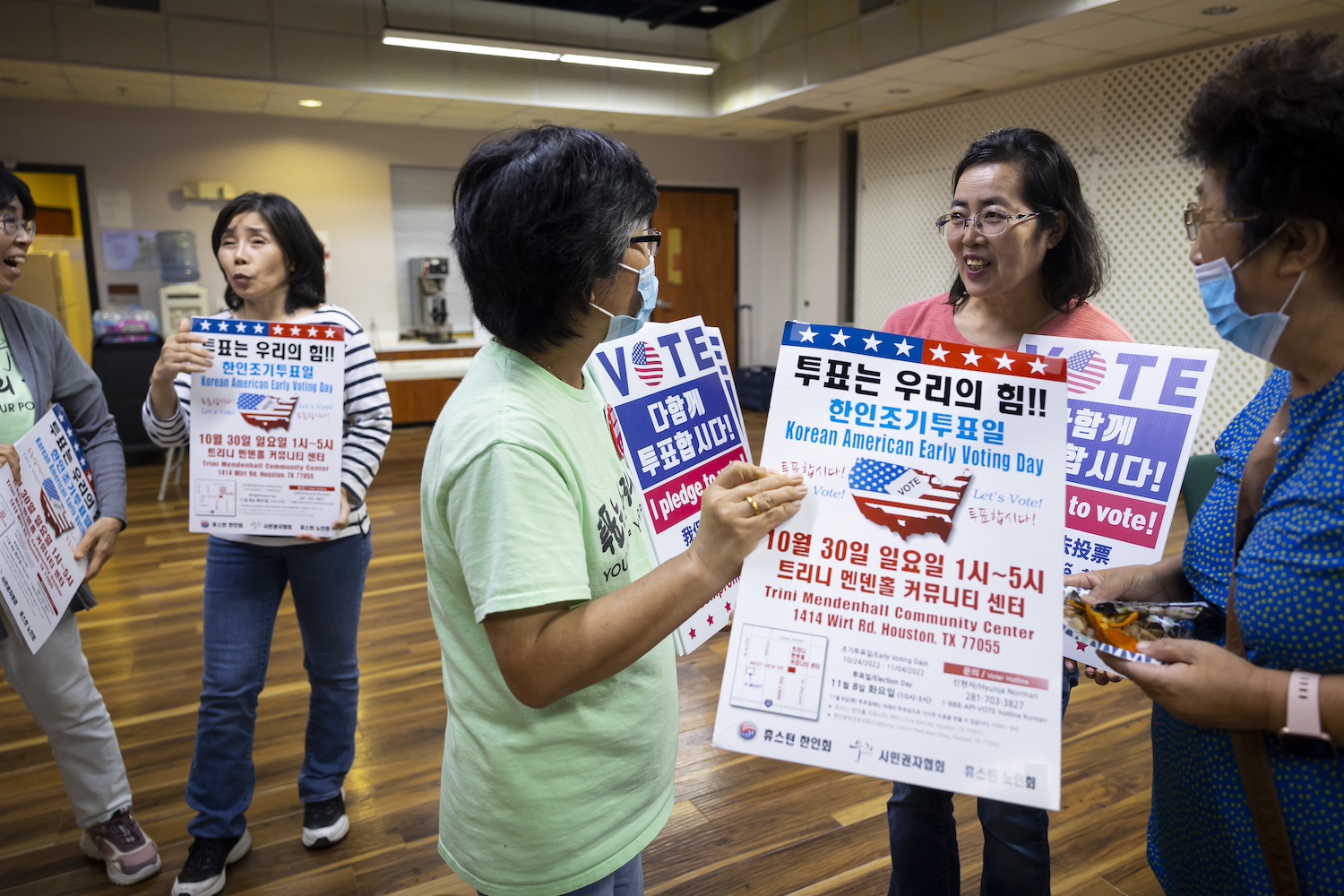
Building trust
That doesn’t mean it’s necessarily easy to connect with all of the immigrant communities in Houston. Outreach and notifications have to be tailored to the different immigrant groups, both culturally and language-wise.
Khmer people from Cambodia and Laotians have different ways of connecting, for example, Nguyễn said. Members of these communities were often hurt by the system, which means it takes a lot of work to build their trust.
“They are very protective of their people, especially when it's small,” Nguyễn said. This means staff often have to connect with trusted members of the community first and collaborate with them to reach others.
Making the most of limited funding
One of the biggest challenges facing immigrant organizations like Woori Juntos is funding, which comes from a combination of grants and private donations.
Only 0.2 percent of all the funding awarded as grants in the U.S. is designated for work in Asian American and Pacific Islander communities, according to a report by the membership organization Asian Americans and Pacific Islanders in Philanthropy.
While Woori Juntos doesn’t turn anyone seeking assistance away, the organization has had connect Central American immigrants with other organizations because it doesn’t have the capacity to help everyone who needs it. The people the organization serves come to the U.S. for a variety of issues — from chasing the American dream to fleeing climate disasters, poverty, and government collapse or abuse — and it’s likely that immigrant groups will continue to grow as the climate crisis worsens and governments struggle to deal with the repercussions. This will only increase the need for groups like Woori Juntos. Whether these organizations will be able to meet the needs of incoming refugees and immigrants will ultimately depend on funding.
Solar Power Reaches New Heights in 2024: Some Big News You May Have Missed
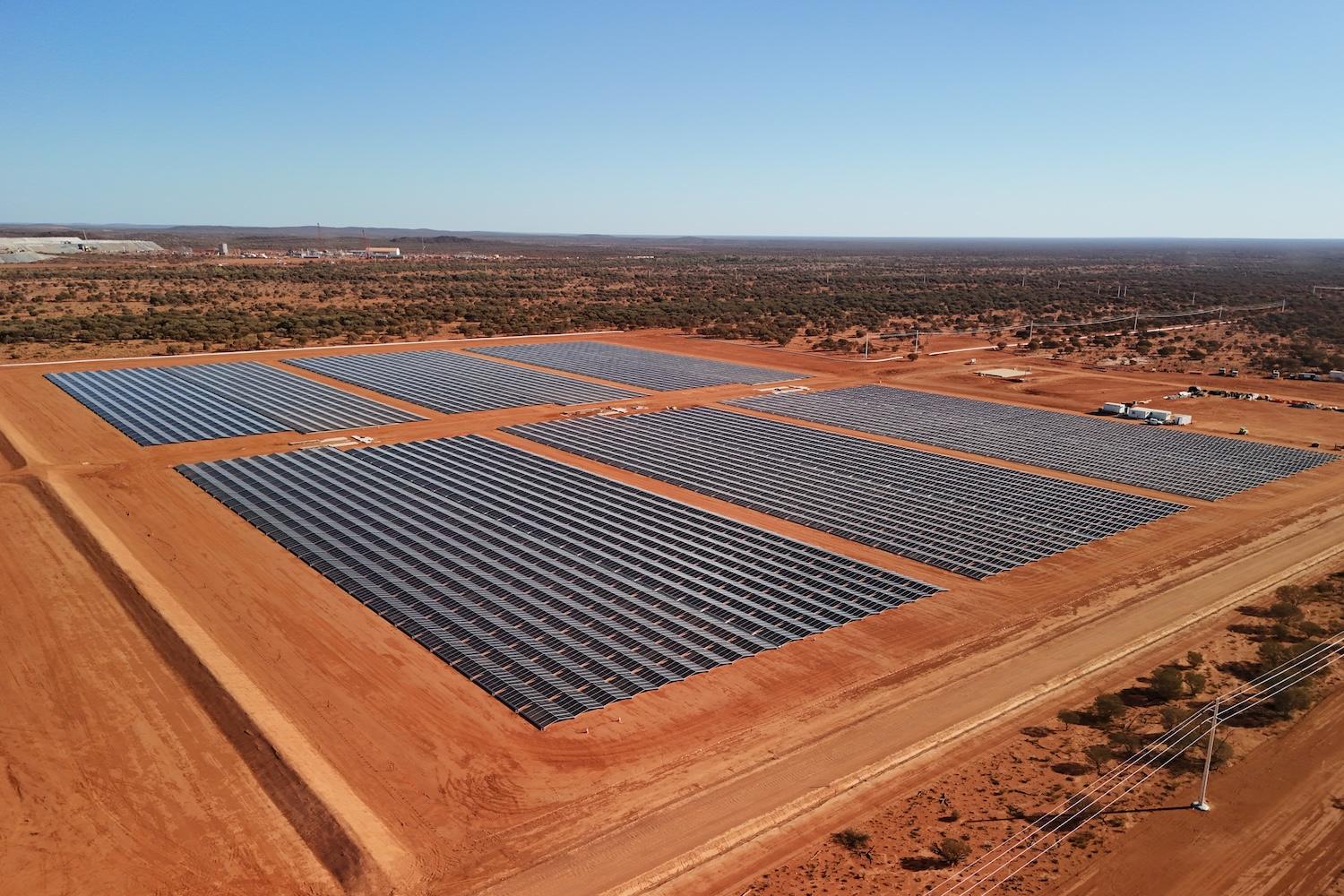
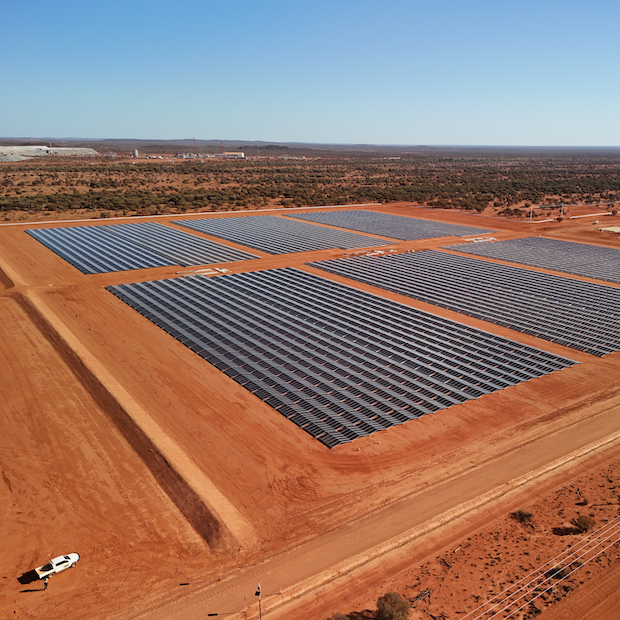
This may look like an ordinary solar farm, but this installation engineered by the Australian startup 5B is actually made up of foldable components that can be deployed far faster than traditional solar arrays. (Image courtesy of 5B)
Renewable energy developers worked for decades to achieve cost parity with the fossil fuel sector, and today renewable technologies are cheaper than oil and gas in most scenarios. As a result, renewable energy projects are booming around the world, and investment in renewables is set to double investment in fossil fuels this year. The solar energy sector in particular is seeing major growth, with a host of large-scale projects coming online and new discoveries with the potential to revolutionize the industry even further.
That's great news, as research shows that meeting a quarter of global power needs with solar would bring us nearly a fifth of the way toward the emission reductions necessary to cap temperature rise at 1.5 degrees Celsius in the fight against climate change. Read on for some of the big solar news you may have missed in the first half of 2024.
Foldable solar energy setups could make construction easier than ever
Solar panels are typically installed individually, which makes constructing large energy installations that can power thousands of homes a time consuming and laborious job. The Australian startup 5B is out to change that with a foldable design that can shrink solar construction time from weeks to days.
The startup devised a way to wire 90 solar panels together into a foldable system that can be unfurled at the development site and snapped into place. Last year in Australia, the system allowed a team of eight workers to cover a soccer field's worth of space with more than 2,000 solar panels in a single day, Fast Company reports.
“Historically, solar farms have been built like a multimillion-piece puzzle ... often in extreme heat,” 5B CEO David Griffin told Fast Company. “It’s expensive, it’s high risk, and it’s increasingly difficult to cost-effectively scale, as solar farms become larger and more remote.”
Along with mainland Australia, 5B's setup was used for a cyclone-resistant solar energy system to power remote communities in the country's Tiwi Islands, which switched on earlier this year. Last month, 5B also inked a major contract for a new solar energy and energy storage system in Puerto Rico, a significant step as the island looks to shift from a highly expensive and fossil fuel dependent electric grid to using more renewable energy.
The world’s biggest solar energy farm could power an entire country
China flipped on the largest solar farm in the world earlier this month, and it's roughly the size of New York City. The average U.S. solar farm generates about 5 megawatts of energy, enough to power roughly 10,000 homes. For comparison, China's new mega array can produce 5 gigawatts, or 1,000 times more energy, which is enough to power a small country the size of Luxembourg, The Independent reports. The massive system is one of many recently deployed in China as it increased solar energy capacity by more than 50 percent last year.
While the installation is a historic feat from a renewable energy standpoint, some human rights watchdogs are concerned about China's solar boom. Investigations indicate the country's solar industry is likely “heavily exposed” to forced labor of the marginalized Uyghur ethnic group, which the Chinese government denies.
This city wants to transform cemeteries into Spain's largest urban solar farm
The city of Valencia, located on Spain's western coast about 200 miles (350 kilometers) south of Barcelona, has a novel idea to turn places of remembrance into hotbeds for solar energy. The fittingly named Requiem in Power (RIP) project launched this month with the first of more than 6,500 solar panels set to be installed at local cemeteries across the city.
If completed, the installation would generate about 440 megawatts of energy per year, making it the largest urban solar farm in Spain. About a quarter of the energy will power 1,000 low-income households, and the rest will be used for municipal buildings, Euronews reports.
Scientists uncover a new way to generate high heat from solar power
While today's solar panels generate energy to power local homes and businesses, the electric grid is just one part of the overall energy system that needs to move away from fossil fuels.
Industrial processes that rely on heat — think: glassmaking, steelmaking and aluminum smelting — consume about 25 percent of the world's energy. Existing solar technologies are generally not well suited for high-heat applications above 1,000 degrees Celsius, but a new proof-of-concept study could crack this limitation wide open.
Researchers at ETH Zurich university in Switzerland used filters made from synthetic quartz and water to absorb infrared radiation from the sun and maximize the absorption of heat. While more research is needed, the quartz-water system they tested was able to "achieve the target temperature with higher efficiency," potentially opening the door for solar power in high-heat industrial applications in the future, the researchers wrote in the journal Device.
The U.S. could see an even bigger solar boom as tariff holiday comes to a close
The United States imposes tariffs on solar panels imported from China, partly due to concerns of forced labor and partly as a means to temper Chinese dominance in the global solar market. U.S. government officials say Chinese solar companies were shifting operations to Southeast Asian countries like Cambodia and Malaysia as a way to evade these fees, and tariffs on panels imported from Southeast Asia came into force this month.
That marks the end of a two-year tariff holiday in which U.S. solar developers were able to source panels from Southeast Asian countries fee-free. Developers stockpiled an estimated 35 gigawatts worth of imported solar panels over the past two years, which is more than the solar energy capacity added across the entire United States in 2023.
Those developers now have just 180 days to use the panels, or they'll have to retroactively pay the tariffs on them. The time crunch could result in a "mini-boom in already red-hot U.S. solar installations" this year, Reuters reports.
How the U.S. Navy is Making Electric Vehicle Batteries Better
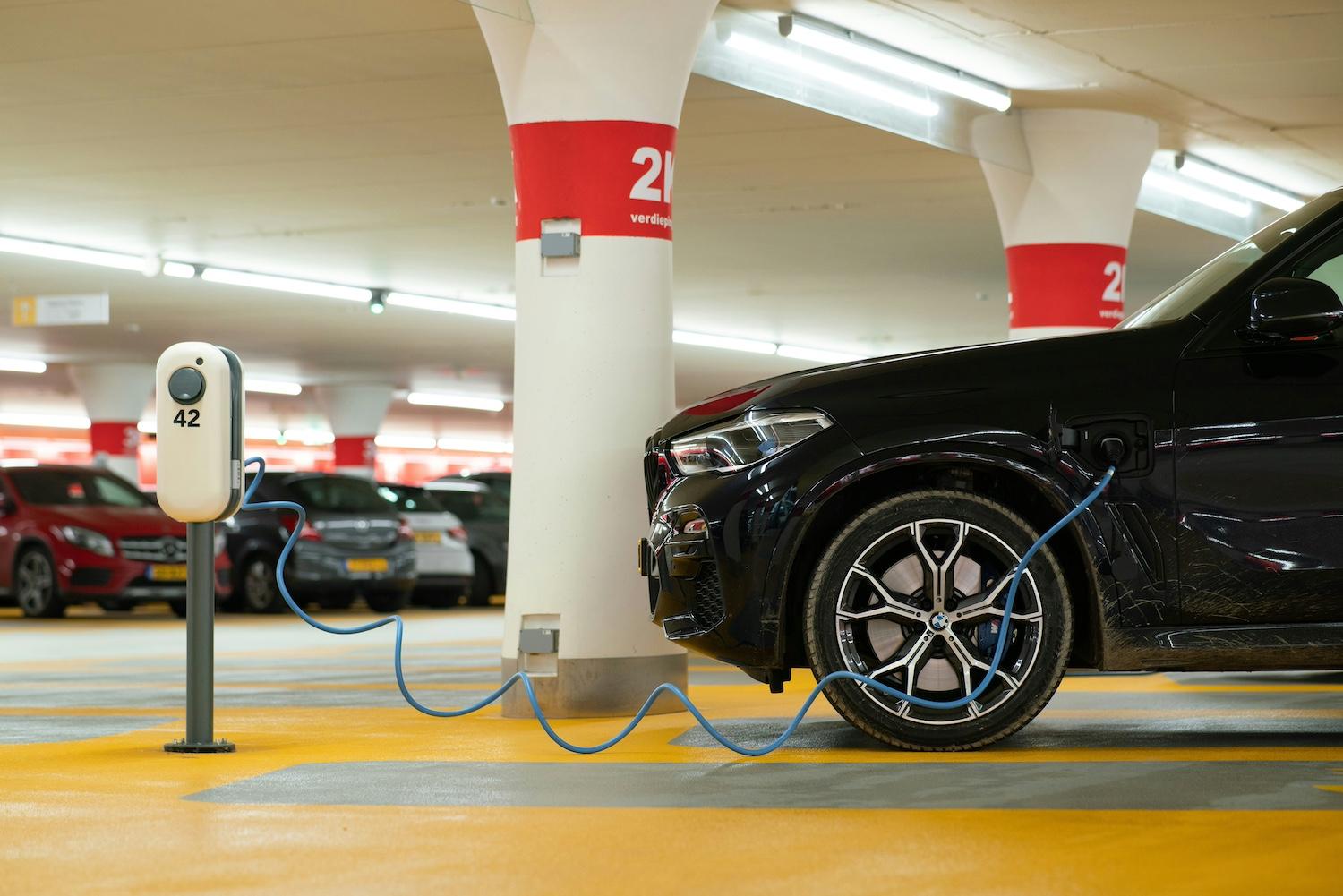
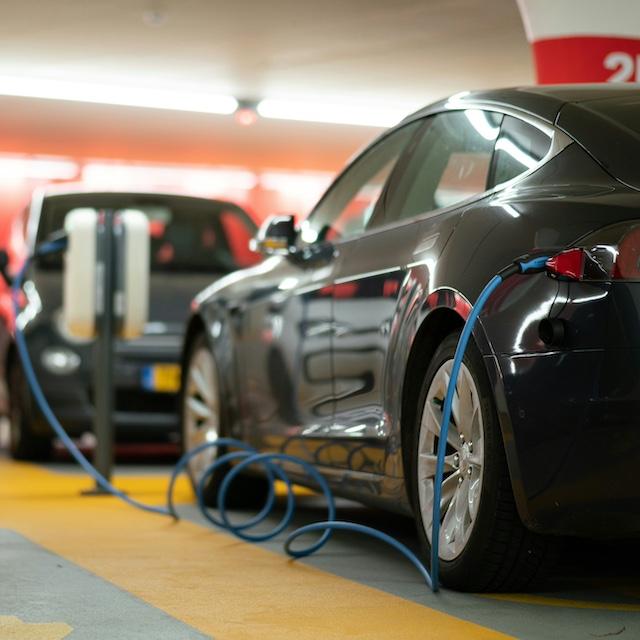
(Image: Michael Fousert/Unsplash)
Lithium is the material of choice for most electric vehicle (EV) batteries due to its high energy density and fast-charging capability. Still, over-reliance on a single technology raises concerns over supply chain security, recycling challenges and environmental impacts. The United States Navy is assisting in the effort to shepherd alternative battery materials into the market, in collaboration with the U.S. zinc battery startup Enzinc.
The long journey to zinc EV batteries
Zinc is a relatively abundant, inexpensive material. It was used to create the first modern battery more than 200 years ago, and it is still commonly used in disposable batteries today. But applying zinc to EV batteries has been a centuries-long challenge. The first electric vehicles of the 19th and early 20th centuries typically used rechargeable lead-acid batteries until lithium-ion batteries emerged in the 21st century.
It was not for lack of trying. In the 1990s, for example, the aerospace and defense technology company Northrup Grumman attempted to develop a mini-submarine with zinc batteries for the U.S. Navy. The batteries failed to perform as expected, and they were replaced with lithium-ion batteries.
That didn’t pan out, either. After the Navy finally took possession of the first mini-sub in 2008, it was destroyed in a fire that started while its lithium-ion batteries were recharging.
That, in a nutshell, sums up the problem. Lithium-ion batteries are high-performing, but without proper handling, their flammable electrolyte is a fire hazard. Zinc batteries are non-flammable but their performance in the rechargeable area is limited.
Energy storage solutions are emerging
The development of effective battery management systems allowed for the safe, widespread use of lithium-ion batteries, though the National Fire Protection Association advises that misuse, damage or improper storage can still lead to fire hazards.
At the same time, zinc technology has also progressed. The U.S. Navy continues to focus on zinc as a non-flammable alternative to lithium-ion batteries, with the U.S. startup Enzinc as a partner.
In 2014 Enzinc received a $452,000 grant from the U.S. Department of Energy to collaborate with the U.S. Naval Research Laboratory on a project aimed at applying a new sponge-like structure to the anodes in zinc batteries. The grant was issued through the Energy Department’s Advanced Research Projects Agency-Energy (ARPA-E) office, which supports new high-risk, high-reward technologies.
“Current zinc-based batteries offer limited cycle life due to the formation of tree-like internal structures (dendrites) that can short out the battery,” according to ARPA-E. “Enzinc’s technology will enable zinc-based batteries that accept high-power charge and discharge as required by EVs. If successful, Enzinc’s zinc-anode technology would reduce EV battery cost by more than 50%, double the amount of energy stored, and allow for greater rechargeability.”
Scaling up zinc battery production
Enzinc credits the ARPA-E grant with enabling it to raise more than $8 million in private and public funding.
“Receiving ARPA-E’s RANGE grant enabled us to work with the U.S. Naval Research Laboratory to develop a revolutionary zinc microsponge anode that makes powerful, safe and sustainable batteries for vehicles, buildings and energy microgrids,” Michael Burz, Enzinc founder and CEO, said in an ARPA-E blog post.
Among the sustainability advantages cited by Burz is the potential for repurposing existing battery factories, rather than building new facilities.
Lead-acid, Nickel-Cadmium, and Nickel-Metal Hydride battery factories currently account for more than 400 gigawatt-hours of production capacity globally, and all three types can be upgraded to accommodate the new zinc battery, according to Enzinc.
Next steps for zinc batteries
The Energy Department has also provided financial support to other zinc battery innovators including the startup Eos, which specializes in stationary, long duration energy storage systems. Last fall, the Energy Department’s Loan Programs Office announced a conditional loan commitment of almost $400 million for Eos to manufacture its new zinc-bromine battery in bulk.
Activity is also stirring elsewhere around the world, with a funding assist from the trade organization Zinc Battery Initiative. Launched in 2020, the initiative is a branch of the International Zinc Association.
The zinc supply chain is more geographically diverse than lithium, and it is more abundant, and a relatively robust global zinc recycling industry is already in place, according to the initiative.
New research is also revealing additional pathways for cutting costs and expanding the application of zinc batteries.
In one recent example, a multinational research team based in China and the U.K. developed an inexpensive alternative to pricey platinum and ruthenium, which are normally needed for zinc-air batteries to charge and discharge efficiently.
Their study, published in the journal Nano Research Energy, supports the use of zinc-air technology to fabricate lightweight, wearable batteries. So far, the team has tested their new battery on small devices including a fan, an LED screen and a mobile phone.
While lithium will continue to exert considerable force in the energy storage market for the foreseeable future, innovations in zinc and other alternatives will help ensure that the battery industry overall can meet the needs of the global economy as energy demand rises and electrification replaces fossil fuels.
iDE Tackles Poverty in Rural Communities with Women-Founded Startups


(Image: Clay Banks/Unsplash)
Female founders are underrepresented in both entrepreneurial and investor roles. They receive just 2.1 percent of venture capital investments, according to Pitchbook market data. This imbalance represents a missed opportunity for innovation and economic growth and has an outsized impact on rural communities that are further away from entrepreneurial resources.
International nonprofit, iDE is dedicated to ending poverty and creating income opportunities for rural communities that are susceptible to this lack of female representation. The ogranization brings together women in less-developed countries with female venture capitalists. Businesswoman and philanthropist, Linda Porter-Cox has served on iDE’s board for six years. In an interview with TriplePundit, Porter-Cox explained how the organization is creating financial prosperity for the communities it operates in.
"There were a lot of factors that really helped me recognize that iDE was a good fit for me,” said Porter-Cox, who is also iDE’s fund development co-chair. “And the most important, I would say, is their focus on long-term transformative and sustainable impact.”
She describes iDE’s work as empowering entrepreneurs to end poverty while enabling, teaching and engaging them in activities that create sustainable outcomes for people and their communities. Since her board tenure, she has learned that women entrepreneurs are key to household prosperity.

Income generated through entrepreneurship contributes to social welfare and reducing poverty. Research reveals a correlation between female entrepreneurship and economic development, gender equality and poverty alleviation. Women entrepreneurs tend to allocate their earnings more towards household expenditures including childcare more than men.
"Fundamentally, everyone should have the opportunity to achieve financial independence,” said Porter-Cox.
iDE’s impact on local entrepreneurs
Over 85 percent of rural Ghananians lack proper sanitation, causing illnesses among adults and developmental issues for children, according to iDE. Sama Sama, a social enterprise supported by iDE in Ghana, was launched in 2016 to provide affordable sanitation and hygiene solutions for low-income communities. The enterprise stemmed from a partnership between iDE and Global Affairs Canada with the aim of developing and selling improved toilets in northern Ghana.
Female entrepreneur Adam Adamu participated in Sama Sama and launched her own toilet business, Rida Enterprise, named after her daughter.
"I was struggling with my income,” Adamu told TriplePundit. “That was the main reason why I joined [iDE] because I come from a nuclear family of seven and I'm the firstborn, and it was my responsibility to assist my siblings. Joining iDE has improved my life."
Adamu receives client acquisition and maintenance support through the enterprise. The organization's support helped her progress from being a low-income earner to a middle-class earner. And her success has garnered praise from community members, especially women, she said. For the future, Adamu is working towards operating her shop independently by selling and carrying her own materials and expanding her business to acquire her own customers.
Ongoing support is key to building strength and stability against poverty
iDE is uniquely working with the purpose and foundation that entrepreneurs can change their community. The solution is not to provide one-off support to tackle poverty but to enable entrepreneurs to solve problems independently and develop lasting resilience against poverty. What sets iDE apart from other nonprofit organizations is its use of human-centered design: iDE thinks globally and acts locally, Porter-Cox told 3p.
“Our organization builds empathy at that local level and design solutions that are the right fit and have the right to succeed,” Porter-Cox said. “Be it in a specific country, a specific community and for a specific area.”
Corporate Composting Could Take Off With New Tech That Removes the 'Ick Factor'
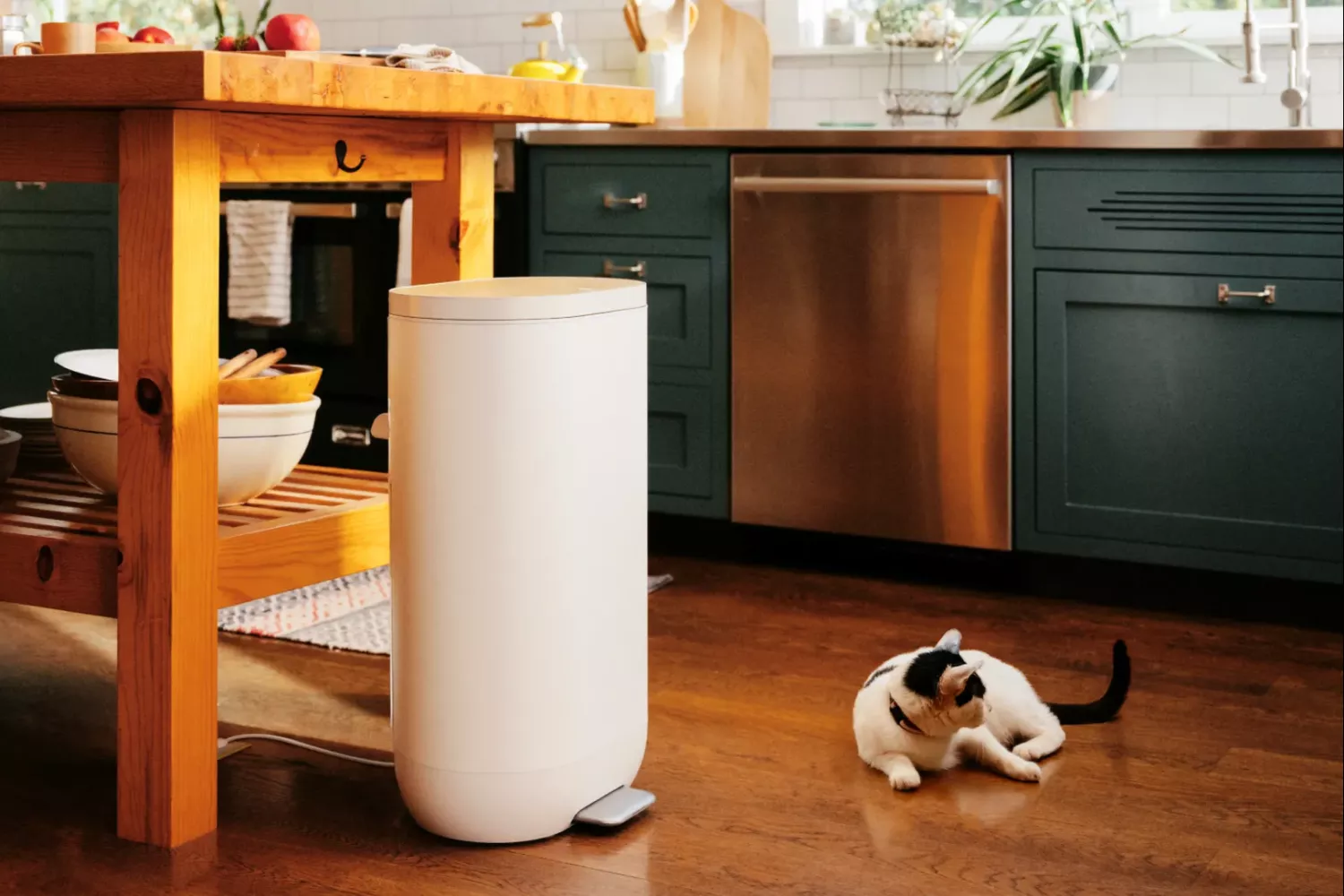
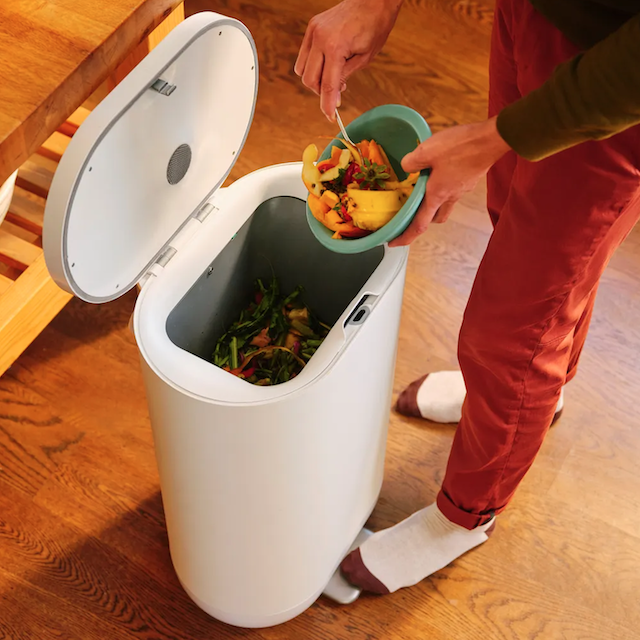
(Image courtesy of Mill Industries.)
Composting food scraps is an effective step that individual households can take to reduce greenhouse gas emissions attributed to food waste and return valuable nutrients to the soil. Though home composting has been slow to gain traction in the U.S., the emerging intersection of new waste management policies and new technology could accelerate the trend and engage office kitchens, too.
Taking the "ick factor" out of food recycling
Notably including New York City, some U.S. jurisdictions are beginning to adopt curbside food waste pickup regulations into their recycling programs. Curbside food waste pickup is a significant step towards reducing greenhouse gas emissions because it enables all residents to compost their scraps, regardless of whether they have a garden, instead of sending them to a landfill or incinerator.
While curbside pickup addresses the garden access problem, it does not account for resistance due to the "ick factor." In the U.S. and elsewhere, widely accepted hygiene standards dictate against storing rotting food in the home or yard.
“Nobody wakes up and says 'I’m excited to waste some food today,' but your options — especially in urban areas — are challenged by what the industry calls the 'ick factor,'” explains Harry Tannenbaum, co-founder of the food recycling company Mill Industries.
In a recent conversation with TriplePundit, Tannenbaum noted that many households are discouraged from composting, mainly due to the risk of attracting fruit flies and other pests. Unpleasant smells and the mere thought of keeping decayed food close at hand are additional obstacles.
The technology solution
Mill Industries’ solution is Mill, a compact, odor-free kitchen appliance that dehydrates food scraps and processes them into clean, dry grounds. The system is designed to handle meat and dairy waste as well as plant-sourced scraps.

The system’s sensors enable it to operate automatically, based on lessons learned from Tannenbaum’s previous experience with the leading smart home firm Nest. The goal was to develop a clean, seamless, and convenient way for households to keep food scraps out of the general waste stream.
“What we learned at Nest is that we need to build things that are better, faster, cheaper, make sense in kitchen, and with less smell and less work,” Tannenbaum told TriplePundit.
Another lesson learned at Nest is the importance of providing users with data and feedback. The Mill weighs incoming food, enabling users to track how many pounds of waste they divert to composting.
Once the food is reduced to dry grounds, it can be spread directly around a yard and garden, incorporated into a compost pile, or added to a curbside food waste recycling bin.
For customers without any of those options, Mill fostered new options with community partners and other stakeholders. In Phoenix, Arizona, a local farmer has agreed to pick up grounds from households. The company also partners with organizations in New York City to link its customers with local community gardens.
As an additional option, the U.S. Postal Service will ship the grounds from the customer to a composting facility.

Access to next-level food waste recycling
Composting is an environmentally acceptable way to reduce food waste, Tannenbaum said. But re-purposing food waste for animal feed yields even bigger environmental gains.
The animal feed option is emerging for Mill Industries’ customers. Earlier this year the Washington State Department of Agriculture approved the distribution of the company’s grounds as an ingredient in poultry feed, the first such commercial application of household-sourced food scraps.
The latest food waste-reducing technology is not for everyone, though. A rental option is available for the Mill, but the retail price is in the range of $1,000.
Opportunities for businesses
The high cost of a high tech food waste converter is beyond the reach of many households, but it can be a good fit for companies in search of new additions to their environmental program budget.
As applied to office use, new composting technology can help employers spark discussions about food waste in general. Apart from the benefits of composting, the conversations can include strategies for reducing food waste at the source and saving money on groceries, including cooking with leftovers, right-sized portions, and planning ahead for meals and grocery shopping.
Every kitchen makes a difference
With global attention focused on big-picture solutions to the climate crisis, companies can also deploy composting to focus attention on the key role of individuals in reducing food waste.
Food waste is both a hunger problem and a greenhouse gas problem. The United Nations estimates that roughly 30 percent of the world’s food is lost to waste. Roughly 13 percent of that loss occurs between harvesting and the retail stage and 17 percent is attributed to retail, food service, and household use, indicating that individual habits can make a significant impact on food waste.
The importance of the individual kitchen is underscored by a 2019 food waste study conducted by the EPA. Still cited today, the study found that 66.2 million tons of food waste occurred in the U.S. in 2019 from the food retail, food service and residential sectors. Households alone accounted for 40 percent of that figure.
The "ick factor" may never go away completely, but companies can help push it to the side by introducing their employees to new solutions that help them make an impact on the global food waste crisis, one kitchen at a time.
A Free Tool is Bringing Farmers and Buyers Together to Eliminate Food Waste


(Image: Carl Tronders/Unsplash)
An estimated 2.5 billion tons of food goes uneaten every year, and a sizable portion of that waste never leaves the farm, according to research from the World Wildlife Fund (WWF). About 15 percent of the food wasted globally is lost during and around harvest. That’s 1.2 billion tons of food. A new, free tool from WWF aims to reduce that number, which could go a long way toward addressing food insecurity and lessening environmental ramifications.
“We care about shrinking the footprint of food [and] using more of what is already being produced,” Alex Nichols-Vinueza, the director of food loss and waste at WWF, told TriplePundit. “We have this overproduction today where almost 40 percent of what we produce goes to waste — and all of the associated impacts around biodiversity loss, conversion [to farmland], water use, greenhouse gas emissions that come with it.”
New tool empowers partnership between growers and buyers
WWF’s Global Farm Loss Tool doesn’t just measure waste, it breaks it down into categories to help growers see just how much food they're losing and where they're losing it, Nichols-Vinueza explained. Since growers can’t solve the problem on their own, that categorization helps growers and buyers work together to get more food out of the field and onto consumers’ plates.
“[It’s] meant for growers to work with buyers, to work with partners, to then come up with these solutions,” he said. “We've done the research where just growers go out into the field and measure but … they can't just take action on their own.”
Buyers, brands and retailers benefit by reducing the environmental impacts and emissions throughout their supply chains.

Solutions are customized for the cause
The tool breaks waste down into marketable, edible and spoilage categories. Each type of loss happens for a different reason and necessitates a different set of solutions. Marketable loss includes fruits and vegetables left in field because of a lack of interested buyers, inclement weather that disrupted the harvest, a shortage of laborers available to complete the harvest, and produce missed by pickers, combines or other machinery, Nichols-Vinueza said.
The edible category consists of foods that are left in field because consumers are likely to reject fruits and vegetables that are scarred, misshapen or the wrong size. While there’s always the hope that consumers will learn to accept edible fruits and vegetables that are not aesthetically perfect, that process can take time to scale up. But there are other solutions, such as selling that produce to cafeterias or food service companies. For example, strawberries that are too small can be distributed to cafeterias, where they can be cut up and served in fruit salads or parfaits without their size being noticeable to consumers, Nichols-Vinueza said.
Additionally, the tool focuses on solutions like upcycling food that would otherwise be wasted surplus and creating new processed foods, he explained.
As far as spoilage is concerned, there are plenty of options outside of sending it to a landfill. It can be composted and used as fertilizer, which could reduce the need for fertilizers by 30 percent and offset their rising cost, Nichols-Vinueza said. And spoiled fruits can be processed for their sugars.
“We're really positioning this [tool] as a piece of that regenerative transition because if you go back to the origins of regenerative agriculture, nothing in nature and nothing in those systems was wasted,” he said. “We're really trying to make sure that, as part of that overall more circular and regenerative system, we're bringing a focus to using more of what we grow. Obviously to feed people first, but then to offset some of our production costs.”
Labor market limitations
Fruits and vegetables are very labor intensive to harvest and produce. The agricultural labor market is limited and expensive, often leaving farms without enough labor, Nichols-Vinueza said.
“We want to get more of what we produce to people, so we're really focused on how do we find an economically profitable way for growers to be able to justify … labor,” he said. “We often get [asked] when we're at events and talking about the work we do on farm, ‘Well why don't you just donate the food?’ And I think every grower would love to see all of their products eaten. It breaks their heart to not be able to use all this food after all the work that went into producing it.”
But both the cost and shortage of labor mean it’s often more economically feasible for growers to leave marketable produce in field, even if it could be sold or donated. Unfortunately, the agricultural labor market is unlikely to improve in the U.S. — especially considering growing anti-immigrant sentiment. This presents a significant challenge to growers who hope to significantly reduce waste.
An example in action
Since the Global Farm Loss Tool is new, evidence is still limited. However, one grower who has used the tool worked with a buyer to reduce waste to an astonishing 0.6 percent by offering their product at a variety of qualities and price points.
“They've got their top-grade fresh apples,” Nichols-Vinueza said. “They've got their bagged apples for a little bit more of a discount. They've got bins of apples if you want to create sauces and pies. And they've got their imperfect line for more of a discount. They've really gone through and, with the partnership with the buyer, established these different products. And that's the end result. They've really been able to reduce a significant amount of their waste.”
Although it will take a while to see more results, it’s a promising example of what the industry can achieve with the right tools and dedication to eliminating waste on the farm.
Phononic’s New Cooling Technology Reduces Grocery Store Emissions
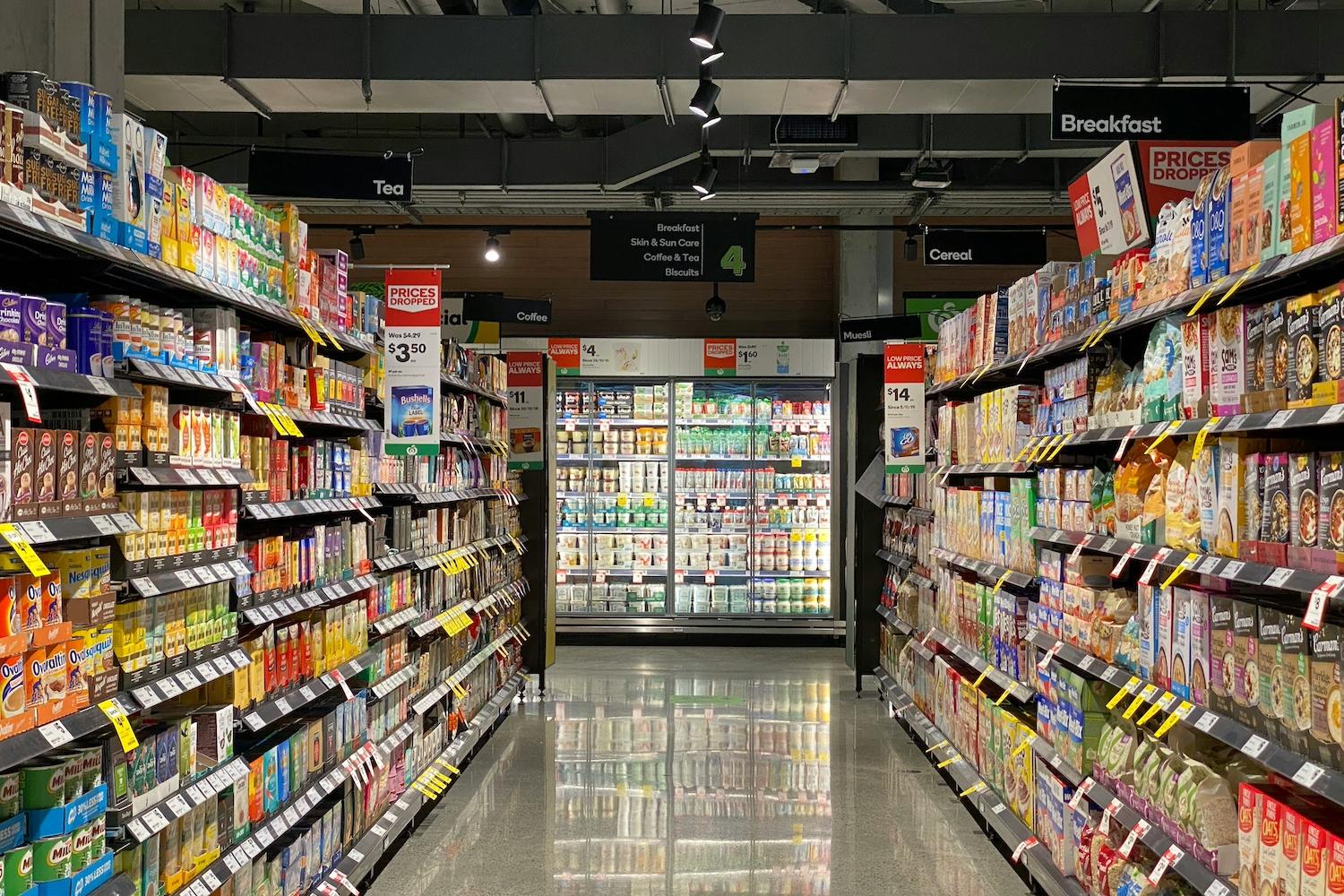
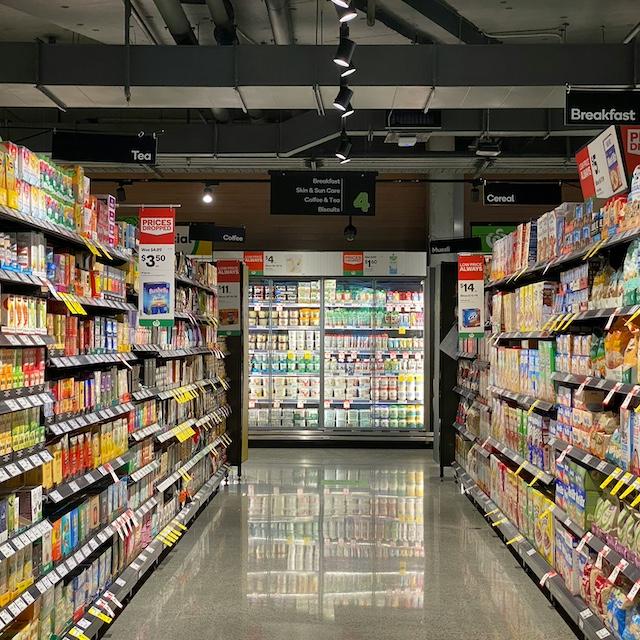
(Image: Franki Chamaki/Unsplash)
The refrigerant gases commonly used to keep the freezer and cold sections of grocery markets at the right temperature contain hydrofluorocarbons, chemicals that can be hundreds to thousands of times more powerful greenhouse gases than carbon dioxide. Consequently, federal and state governments are seeking to regulate their use, which could mean big changes for a lot of businesses. In response, some of the largest grocery chains in the country are switching to natural refrigerants — like ammonia, carbon dioxide and propane — to reduce their environmental impact.
Phononic, a company specializing in heating and cooling technology, developed a cooling option that doesn’t use refrigerants, and it appears to be well suited for an increasingly popular form of grocery shopping: curbside and delivery orders.
“The problem with e-commerce purchasing, particularly online for pickup and delivery, is the grocer can’t predict your behavior and that makes warehousing particularly problematic,” Tony Atti, co-founder and CEO of Phononic, told TriplePundit. “The minute they build a fixed, refrigerated or frozen warehouse, they’re either using a small percentage of their capacity or exceeding the capacity, and they have no flexibility.”
The company is named for a solid-state cooling process that doesn’t rely on moving parts or fluids like traditional refrigeration systems. Instead, it utilizes the principles of thermoelectricity to transfer heat away from an object or space. Phononic created moveable freezer and refrigerator totes for picking and storing online orders while saving space in-store. This technology is more sustainable and cost-effective because it doesn’t use traditional refrigerants and the totes’ temperatures can be customized, so stores are only cooling products that need to be and aren’t cooling empty totes.
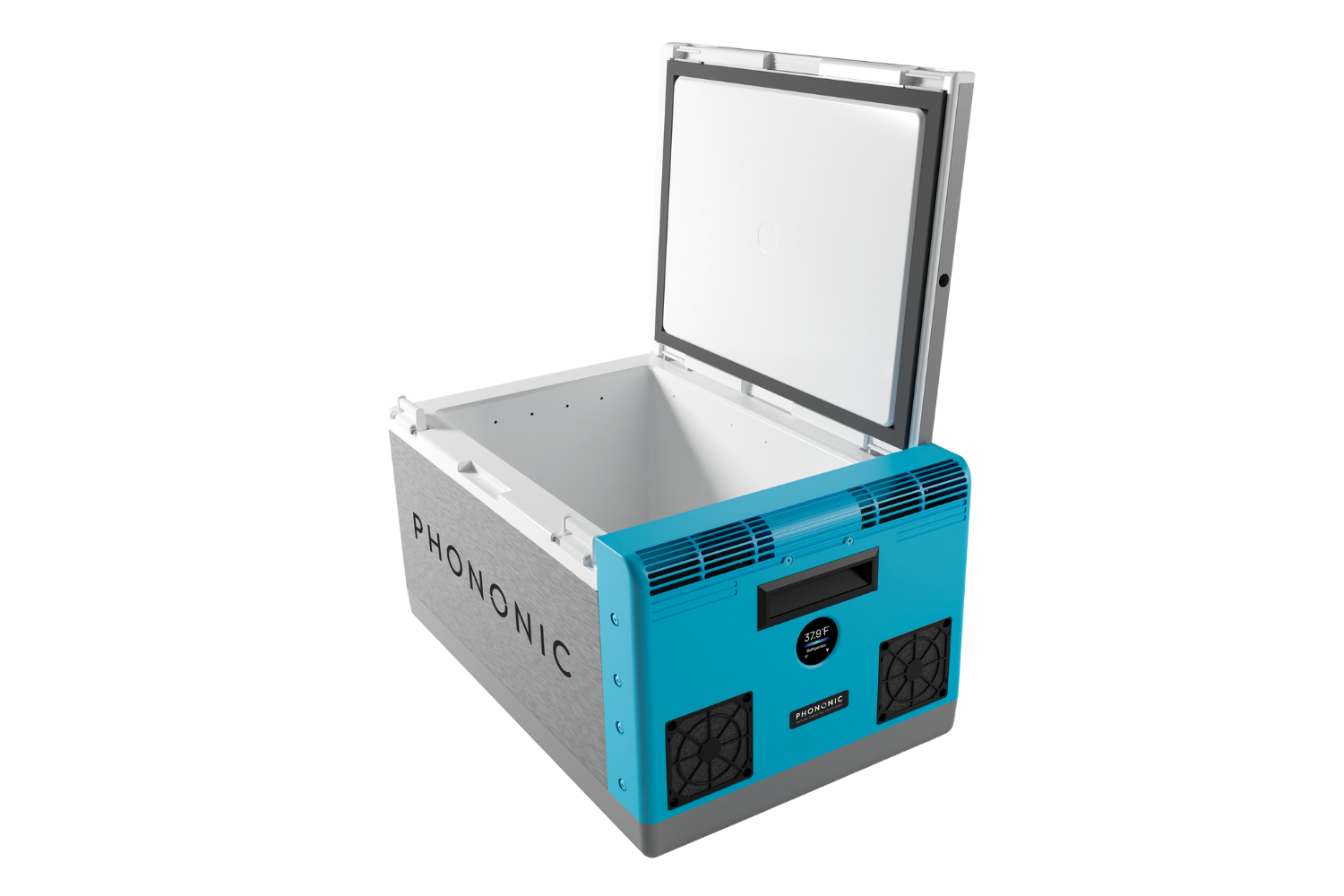
Traditional freezer and cooling systems involve mechanical compressor-driven pumps that use the expansion and contraction of refrigerant gases to generate coldness and blow that coldness across a surface to cool it, Atti said.
“Thermoelectric, semiconductor cooling is a complete inverse,” Atti said. “We pull heat out as opposed to pushing cold in. When you do that, you have a very elegant, very uniform, and consistent level of temperature — as compared to the mechanical, sort of, brute-force method.”
With grocery stores of all sizes establishing or scaling online purchasing platforms for their customers, the dilemma is twofold, Atti said.
“You don’t want to mess up the in-store purchasing experience for people that like to go to the store,” Atti said. “Instead, the grocer has to take a portion of the real estate and dedicate it to fulfillment, which is a fancy word for ‘Where do we pack your order?’”
The fulfillment area needs its own sets of refrigerators and freezers for goods that need to be kept cool, Atti said. Those are often fixed, expensive, unsustainable, and require separate power from the rest of the store.
Phononic’s totes, on the other hand, are part of an “ecosystem of accessories, racks, carts and data monitoring” that tells the grocer where the order is at every point of the fulfillment cycle, Atti said.
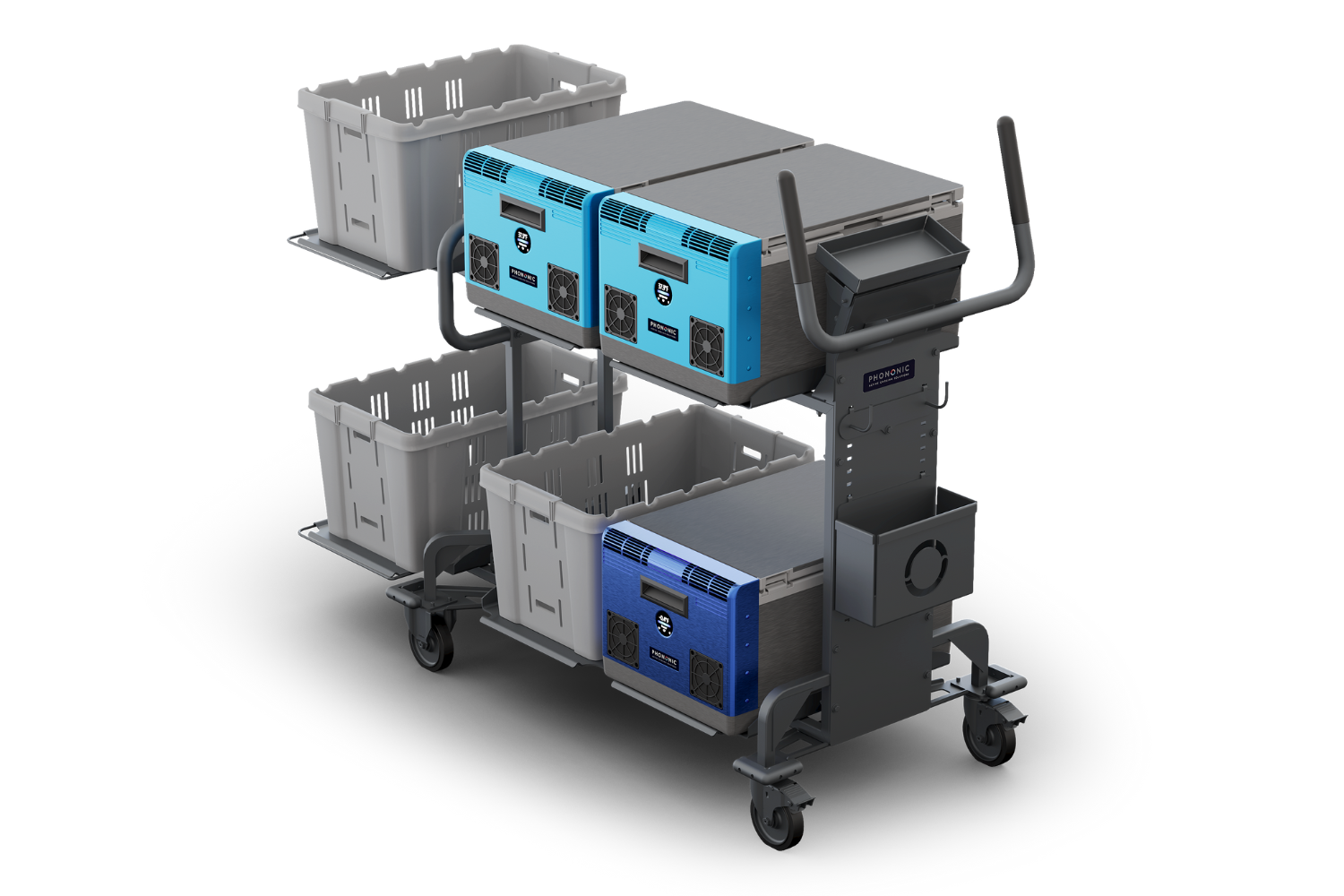
“So, the grocer now has an incredibly flexible allocation of their space that can accommodate orders in real-time as opposed to a fixed ordering capacity using the legacy technology,” Atti said.
Phononic’s freezer and refrigerator totes can deliver energy savings from 30 to 70 percent over fixed, stationary refrigerator units, he said. In many cases, grocers also saw labor savings of 50 to 60 percent.
“Then at the same time in several stores, we’re seeing significant incremental revenue growth from just that fulfillment area,” Atti said. “It’s a really unique way to impact three significant areas of operation: first sales, then labor, and third, the infrastructure footprint or, more directly, the energy bill.”
But solid-state cooling technology has its limitations, including lower cooling capacities compared to traditional methods and higher costs for certain applications. Phononic and other companies are conducting ongoing research to overcome these limitations and expand the use of solid-state cooling in multiple fields, including electronics, medical devices and consumer appliances.